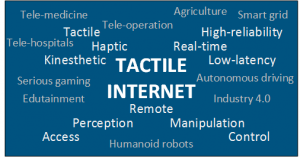Recently, the Tactile Internet has been defined by the IEEE P1918.1 Tactile Internet ad-hoc definition group as:
“A network or network of networks for remotely accessing, perceiving, manipulating or controlling real or virtual objects or processes in perceived real time by humans or machines.”
The Tactile Internet (TI) Technical Committee focuses on exploring and elucidating all facets of the next generation of the “Tactile Internet” technology, business, and societal gaps and challenges.
Extremely low latency in combination with high availability, reliability and security will define the character of TI applications. It will have a marked impact on business and society, introducing numerous new opportunities for emerging technology markets and the delivery of essential public services.
The objectives of the TI Technical Committee are to facilitate the worldwide harmonization of research, pre-standardization, and best practices for deployment user scenarios of the global TI ecosystem, to design the built-in security and privacy and to explore ways the tactile technology can be realized in different segments such as in engineering, automobile, transport and logistics, health service, and public. The TI technical committee targets the understanding of the Tactile Internet requirements, defining system specifications to meet these requirements, and developing breakthrough technology to the identified challenges of the Tactile Internet. Hence, the TI Technical Committee’s scope covers topics ranging from joint communication, computing, and sensing to cooperative perception, networked control, and Tactile Internet applications with human-in-the-loop, and cyber physical and virtual systems.


